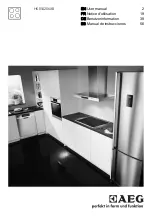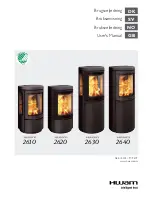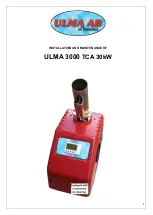
English
IN ST AL LA TI ON MAN UA L
Any existing chimney must be clear of obstruction and have been swept clean immediately before installation of
the stove. If the stove is fitted in place of an open fire then the chimney should be swept one month after
installation to clear any soot falls which may have occurred due to the difference in combustion between the
stove and the open fire. If there is no existing chimney then any new system must be to the designation described
above and in accordance with Building Regulations Approved Document J.A single wall metal fluepipe is suitable
for connecting the stove to the chimney but is not suitable for use as the complete chimney. The chimney and
connecting fluepipe must have a minimum diameter and its dimension should be not less than the size of the
outlet socket of the stove (see Annex 1, table 2).
Any bend in the chimney or connecting fluepipe should not exceed 45°. 90° bends should not be used.
Combustible material should not be located where the heat dissipating through the walls of fireplaces or flues
could ignite it. Therefore when installing the stove in the presence of combustible materials due account must be
taken of the guidance on the separation of combustible material given in Building Regulations Approved
Document J and also in these stove instructions.
If it is found that there is excessive draught in the chimney then a draught stabiliser should be fitted. Fitting of a
draught stabiliser will affect the requirement for the permanent air supply into the room in which the stove is
fitted in accordance with Approved Document J (see also combustion air supply).
Commissioning and handover
Ensure all parts are fitted in accordance with the instructions.
On completion of the installation allow a suitable period of time for any fire cement and mortar to dry out, before
lighting the stove. Once the stove is under fire check all seals for soundness and check that the flue is functioning
correctly and that all products of combustion are vented safely to atmosphere via the chimney terminal. On
completion of the installation and commissioning ensure that the operating instructions for the stove are left with
the customer. Ensure to advise the customer on the correct use of the appliance and warn them to use only the
recommended fuel for the stove.
Advise the user what to do should smoke or fumes be emitted from the stove. The customer should be warned to
use a fireguard to BS 8423:2002 (Replaces BS 6539) in the presence of children, aged and/or infirm persons.
Warning note on fume emission
Properly installed, operated and maintained this appliance will not emit fumes into the dwelling.
Occasional fumes from de-ashing and re-fuelling may occur. However, persistent fume emission is potentially
dangerous and must not be tolerated. If fume emission does persist, the following immediate actions should be
taken:
a) Open doors and windows to ventilate room.
b) Let the fire out or eject and safely dispose of fuel from the appliance.
c) Check for flue or chimney blockage, and clean if required.
Do not attempt to relight the fire until the cause of the fume emission has been identified and corrected. If
necessary seek expert advice.
Extractor fan
There must not be an extractor fan fitted in the same room as the stove as this can cause the stove to emit smoke
and fumes into the room.
Permanent air vent
The stove requires a permanent and adequate air supply in order for it to operate safely and efficiently.
In accordance with current Building Regulations the installer may have fitted a permanent air supply vent into the
room in which the stove is installed to provide combustion air. This air vent should not under any circumstances
be shut off or sealed.
Chimney cleaning
The chimney should be swept at least twice a year. It is important that the flue connection and chimney are swept
prior to lighting up after a prolonged shutdown period. If the stove is fitted in place of an open fire then the
chimney will require sweeping after a month of continuous operation. This is a precaution to ensure that any
“softer” deposits left from the open fire usage have not been loosened by the higher flue temperatures generated
by the closed stove.
Periods of Prolonged Non-Use
If the stove is to be left unused for a prolonged period of time then it should be given a thorough clean to remove
ash and unburned fuel residues. To enable a good flow of air through the appliance to reduce condensation and
subsequent damage, leave the air controls fully open.
UK
Summary of Contents for Instyle 600V Next
Page 24: ...N e d e r l a n d s 24 ...
Page 46: ...E n g l i s h 46 ...
Page 60: ...D e u t s c h INSTALLATIONSANLEITUNG 60 ...
Page 66: ...D e u t s c h INSTALLATIONSANLEITUNG 66 ...
Page 82: ...F r a n ç a i s MANUEL D INSTALLATION 82 ...
Page 90: ...F r a n ç a i s 90 ...
Page 95: ...2 3 1 52c 0290 2 3 1 52c 0291 4 5 95 ...
Page 96: ...52c 0283 1 2 3 52c 0284 2 1 7 6 96 ...
Page 97: ...52c 0289 1 2 3 52c 0292 1 2 3 4 5 9 8 97 ...
Page 98: ...1b 3 1a 4 52c 0299 3x 3x 52c 0295 1 2 11 10 98 ...
Page 100: ...52c 0287 1 2 3 52c 0288 1 2 3 15 14 100 ...
Page 101: ...101 ...
Page 108: ......
Page 109: ......
Page 110: ......
Page 111: ......
















































